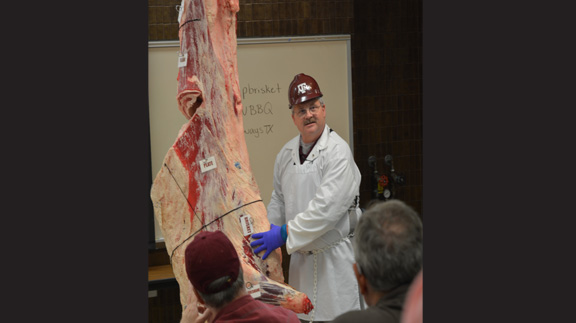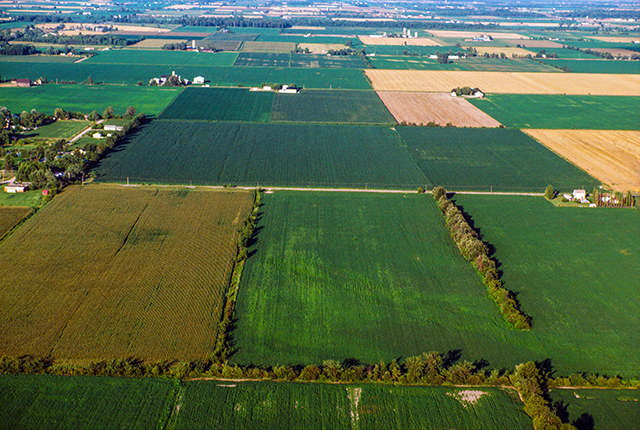Country Lifestyles
Camp Brisket draws all walks of life to learn finer points of Texas’ most popular cut for barbecue

By: Blair Fannin
Writer: Blair Fannin, 979-845-2259, [email protected]
COLLEGE STATION – From doctors and computer information technologists to restaurant owners, 2015 Camp Brisket participants learned the finer points of cooking one of the most popular barbecue cuts found throughout Texas.
Dr. Jeff Savell, distinguished professor in the department of animal science at Texas A&M University, led the camp and was joined by Dr. Davey Griffin, Texas A&M AgriLife Extension Service meat specialist, and Ray Riley, manager of the E.M. “Manny” Rosenthal Meat Center at Texas A&M.
The camp is a partnership between Foodways Texas and the meat science section in the department of animal science. Event registration sold out in less than five minutes, according to organizers, and various national and state media reported from the event.
According to Savell, “There are three foods in Texas: Texas barbecue, chicken fried steak and Tex-Mex. You don’t see anybody standing in line for chicken fried steak or Tex-Mex, but they are standing in line for the best barbecue.”
More than 100 attendees learned where the brisket and other barbecue cuts come from on a side of beef, proper trimming and preferred seasoning methods, plus the many different types of barbecue pits and wood smoke used during cooking.
“You find a lot of people attending this camp who have achieved success in cooking other cuts, but they keep coming back to brisket,” Savell said.
Trying to cook brisket consistently is one of the most unique challenges among barbecue cooking, Savell said. Griffin provided an overview of the anatomy of a brisket demonstrating the various cuts from a side of beef.
Barbecue restaurant owners and experts were also featured speakers during the two-day event. A pitmaster panel on cooking briskets featured Bryan Bracewell of Southside Market and Barbecue in Elgin, Aaron Franklin of Franklin Barbecue in Austin, Wayne Mueller of Louie Mueller Barbecue in Taylor, and Russell Roegels of Roegels Barbecue Co. in Houston.
Though beef prices continue to be high due to lack of supply, Savell said, consumers’ hunger for barbecue is greater than ever.
During a three-year period beginning in 2010, drought conditions led to 1 million fewer beef cows in Texas alone. Nationally, cattle inventory levels are the lowest since the 1950s, consequently affecting the price and availability of beef.
“There are fewer briskets today, but stronger demand,” he said.
-30-
Country Lifestyles
While We Were Sleeping

By Martha Crump
That old adage, “What you don’t know won’t hurt you.,” may have some basis in truth when applied to minor situations. However, when what you don’t know is presented in the form of a “Trojan Horse” and is what amounts to an incredible attempt to fleece American property rights, it becomes a different story altogether.
To put this unbelievable tale together, we need to step back to Joe Biden’s 2021 Executive Order which pledged commitment to help restore balance on public lands and waters, to create jobs, and to provide a path to align the management of America’s public lands and waters with our nation’s climate, conservation, and clean energy goals.
To read more, pick up a copy of the April issue of NTFR magazine. To subscribe by mail, call 940-872-5922.
Country Lifestyles
Lacey’s Pantry: Strawberry Sorbet

By Lacey Vilhauer
Ingredients:
1 whole lemon, seeded and roughly chopped
2 cups sugar
2 pounds strawberries, hulled
Juice of 1 to 2 lemons
¼ cup water
Directions:
Place the chopped lemon and sugar in a food processor and pulse until combined. Transfer to a large bowl. Puree the strawberries in a food processor and add to the lemon mixture along with juice of one lemon and water. Taste and add more juice as desired.
To read more, pick up a copy of the April issue of NTFR magazine. To subscribe by mail, call 940-872-5922.
Country Lifestyles
A Mountain Out of a Molehill

By Nicholas Waters
As winter plods along – come Spring and gopher mounds – homeowners and farmers find themselves playing a familiar song – fiddling while Rome is burning.
Let’s make a mountain out of a molehill. Those mounds on your lawn and pasture could be moles, but they’re more than likely gophers; Plains Pocket Gophers to be pragmatic – Geomys bursarius to be scientific.
These rodents dig and chew, and the damage they can do goes beyond the mounds we mow over. Iowa State University cited a study in Nebraska showing a 35 percent loss in irrigated alfalfa fields due to the presence of pocket gophers; the number jumped to 46 percent in decreased production of non-irrigated alfalfa fields.
The internet is replete with academic research from coast-to-coast on how to curtail gopher populations, or at least control them. Kansas State University – then called Kansas State Agricultural College – also published a book [Bulletin 152] in February 1908 focused exclusively on the pocket gopher.
To read more, pick up a copy of the April issue of NTFR magazine. To subscribe by mail, call 940-872-5922.
-

 Country Lifestyles1 year ago
Country Lifestyles1 year agoScott & Stacey Schumacher: A Growth Mindset
-

 Equine7 months ago
Equine7 months agoThe Will to Win
-

 Country Lifestyles7 years ago
Country Lifestyles7 years agoStyle Your Profile – What your style cowboy hat says about you and new trends in 2017
-

 Country Lifestyles4 years ago
Country Lifestyles4 years agoAmber Crawford, Breakaway Roper
-

 HOME7 years ago
HOME7 years agoGrazing North Texas – Wilman Lovegrass
-

 Country Lifestyles7 years ago
Country Lifestyles7 years agoDecember 2016 Profile, Rusty Riddle – The Riddle Way
-

 Country Lifestyles8 years ago
Country Lifestyles8 years agoJune 2016 Profile – The man behind the mic: Bob Tallman
-

 Outdoor9 years ago
Outdoor9 years agoButtercup or Primrose?






